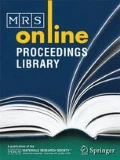Abstract
A molecular model for cooperative segmental relaxation has been proposed, which leads to the Adam-Gibbs type dependence of the characteristic relaxation time on temperature and the configurational entropy. When the size distribution for the cooperative domains is introduced, the resulting relaxation spectrum is similar to the Kohlrausch-Williams-Watts (KWW) equation in the frequency range near the loss maximum, but the fit is actually better in the high frequency extremes where the KWW equation always underpredicts the intensity. The model also predicts the broad spread of the spectrum in the non-equilibrium state from the distribution of the apparent activation energy arising from the different sizes of domains. p]We now extend this model to the yield phenomenon in glassy polymers. Under the stress, a domain has two alternatives to dissipate the strain energy. One way is to relieve the stress at the rate dictated by the linear viscoelastic relaxation time. This process is possible only when the strain rate is low. At above a certain strain rate, the stress reaches the strength of the domain, forcing to irreversibly break up the domain structure in the manner that can be described by the classical plasticity. It can be shown that the yield stress of a real polymer is a combination of the above two types of stresses. Namely, at a given strain rate, the small domains with short relaxation time will attain the linear viscoelastic steady stress while the larger domains reach the (limiting) plastic yield stress. Thus, the strain rate dependence of yield stress can be predicted from the linear viscoelastic relaxation spectra, even though the yield phenomenon is clearly in the realm of nonlinear viscoelasticity.
Similar content being viewed by others
References
McClintock, F. A.; and Argon, A. S.; Mechanical Behavior of MaterialsAddison-Wesley, Reading, MA, 1966.
Struik, L. C. E.; Lecture at the 1990 International Conference on Relaxation in Complex Systems, 18-29 June, Heraklion, Crete
Matsuoka, S.; and Quan, X.; Submitted to Macromolecules
Matsuoka, S.; "Failure of Plastics", Brostow and Corneliussen, ed., Hanser
Author information
Authors and Affiliations
Rights and permissions
About this article
Cite this article
Matsuoka, S. Cooperative Domain Model for Yield Phenomenon. MRS Online Proceedings Library 215, 71–80 (1990). https://doi.org/10.1557/PROC-215-71
Published:
Issue Date:
DOI: https://doi.org/10.1557/PROC-215-71



